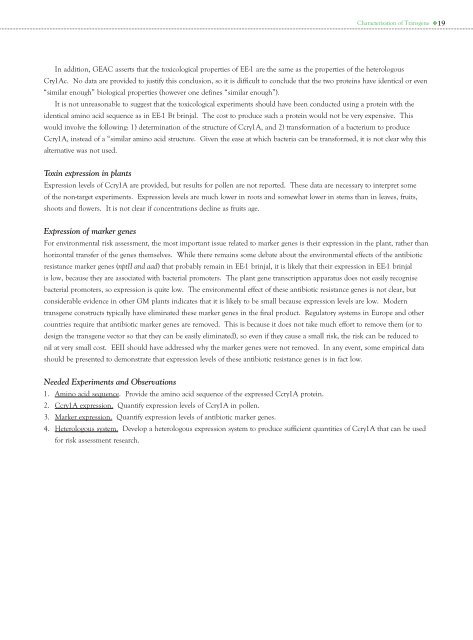Bt Brinjal The scope and adequacy of the GEAC environmental risk assessment
Bt Brinjal: The scope and adequacy of the GEAC ... - Down To Earth
Bt Brinjal: The scope and adequacy of the GEAC ... - Down To Earth
- No tags were found...
Create successful ePaper yourself
Turn your PDF publications into a flip-book with our unique Google optimized e-Paper software.
Characterisation <strong>of</strong> Transgene 19In addition, <strong>GEAC</strong> asserts that <strong>the</strong> toxicological properties <strong>of</strong> EE-1 are <strong>the</strong> same as <strong>the</strong> properties <strong>of</strong> <strong>the</strong> heterologousCry1Ac. No data are provided to justify this conclusion, so it is difficult to conclude that <strong>the</strong> two proteins have identical or even“similar enough” biological properties (however one defines “similar enough”).It is not unreasonable to suggest that <strong>the</strong> toxicological experiments should have been conducted using a protein with <strong>the</strong>identical amino acid sequence as in EE-1 <strong>Bt</strong> brinjal. <strong>The</strong> cost to produce such a protein would not be very expensive. Thiswould involve <strong>the</strong> following: 1) determination <strong>of</strong> <strong>the</strong> structure <strong>of</strong> Ccry1A, <strong>and</strong> 2) transformation <strong>of</strong> a bacterium to produceCcry1A, instead <strong>of</strong> a “similar amino acid structure. Given <strong>the</strong> ease at which bacteria can be transformed, it is not clear why thisalternative was not used.Toxin expression in plantsExpression levels <strong>of</strong> Ccry1A are provided, but results for pollen are not reported. <strong>The</strong>se data are necessary to interpret some<strong>of</strong> <strong>the</strong> non-target experiments. Expression levels are much lower in roots <strong>and</strong> somewhat lower in stems than in leaves, fruits,shoots <strong>and</strong> flowers. It is not clear if concentrations decline as fruits age.Expression <strong>of</strong> marker genesFor <strong>environmental</strong> <strong>risk</strong> <strong>assessment</strong>, <strong>the</strong> most important issue related to marker genes is <strong>the</strong>ir expression in <strong>the</strong> plant, ra<strong>the</strong>r thanhorizontal transfer <strong>of</strong> <strong>the</strong> genes <strong>the</strong>mselves. While <strong>the</strong>re remains some debate about <strong>the</strong> <strong>environmental</strong> effects <strong>of</strong> <strong>the</strong> antibioticresistance marker genes (nptII <strong>and</strong> aad) that probably remain in EE-1 brinjal, it is likely that <strong>the</strong>ir expression in EE-1 brinjalis low, because <strong>the</strong>y are associated with bacterial promoters. <strong>The</strong> plant gene transcription apparatus does not easily recognisebacterial promoters, so expression is quite low. <strong>The</strong> <strong>environmental</strong> effect <strong>of</strong> <strong>the</strong>se antibiotic resistance genes is not clear, butconsiderable evidence in o<strong>the</strong>r GM plants indicates that it is likely to be small because expression levels are low. Moderntransgene constructs typically have eliminated <strong>the</strong>se marker genes in <strong>the</strong> final product. Regulatory systems in Europe <strong>and</strong> o<strong>the</strong>rcountries require that antibiotic marker genes are removed. This is because it does not take much effort to remove <strong>the</strong>m (or todesign <strong>the</strong> transgene vector so that <strong>the</strong>y can be easily eliminated), so even if <strong>the</strong>y cause a small <strong>risk</strong>, <strong>the</strong> <strong>risk</strong> can be reduced tonil at very small cost. EEII should have addressed why <strong>the</strong> marker genes were not removed. In any event, some empirical datashould be presented to demonstrate that expression levels <strong>of</strong> <strong>the</strong>se antibiotic resistance genes is in fact low.Needed Experiments <strong>and</strong> Observations1. Amino acid sequence. Provide <strong>the</strong> amino acid sequence <strong>of</strong> <strong>the</strong> expressed Ccry1A protein.2. Ccry1A expression. Quantify expression levels <strong>of</strong> Ccry1A in pollen.3. Marker expression. Quantify expression levels <strong>of</strong> antibiotic marker genes.4. Heterologous system. Develop a heterologous expression system to produce sufficient quantities <strong>of</strong> Ccry1A that can be usedfor <strong>risk</strong> <strong>assessment</strong> research.











